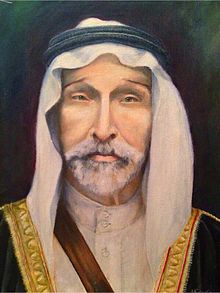Bani Sakher


The Beni Sakhar confederacy is one of the largest and most influential tribal confederacies in both Lebanon and Jordan. Its founder, Sakher bin Tha'labah al Tayy likely lived in the 3rd century AD, making the tribe around 18 centuries old. The Bani Sakher began migrating to The Levant as early as the 16th century and grew to become an influential tribe as by around the mid 18th century.[1] The Beni Sakher is made out of many clans, both through ancestry and alliances. These clans are primarily separated into three groups, Al-Twaqa headed by the princely Al-Fayez family, Al-Ka'abneh headed by the Khreisha family, and Al-Khdeir.[2]
History
Origin
The Bani Sakher was a tribe title that was given to more than one tribe, but the greatest and most famous of this tribes are the sons of Sakher bin Tha'labah bin Amro bin Alghouth bin
Then the Bani Sakher migrated to occupy the lands
In Frederick's book, he also documented the clash between Bani Sakher and the Al-Dhafeer tribes and that they defeated Al-Dhafeer. However, Al-Dhafeer regrouped again under the leadership of their knight Sultan Ibn Suwit, and followed Bani Sakher, whom where heading heading north of the Arabian Peninsula. The two tribes met again in Wadi Azraq, now known as Azraq, on the Saudi-Jordanian border. Banu Sakher was able once again to defeat the tribes of Al-Dhafeer, killing Sheikh Sultan Ibn Suwit where he lies in his tomb in that region next to a water ravine that was named after him (Ghadeer Sultan).[citation needed]
The Bani Sakher then headed towards Al-Balqa however their stay did not last long because the tribes didn't welcome them, most notably the Al-Adwan (العدوان) whom where extending their influence over the region. The Bani Sakher went to Palestine and stayed for a period of time until they soon returned to Al-Balqa. At this time, the area was under the sovereignty of the Sardiyya tribe, which was imposing a tax on the tribes that inhabited the areas in and around Al-Balqa, however when the Bani Sakher returned, they refused to get taxed, which led to a heated situation between them.[citation needed]
This conflict lead to the first alliance between Bani Sakher and Al-Adwan where they joined forces with the intent to annihilate the Sardiyya tribe.[citation needed]
Background
In the 1799, the Beni Sakher joined the Es-Sabhah and other tribes in a full-scale
In the 19th century, the Beni Sakher lived as nomads. Their income came from their monopoly in trading camels and from the protection they could gave to pilgrims and visitors. In 1867, the Ottoman Empire launched a raid which defeated the Beni Sakher and ended their practice of collecting khuwwa (protection money) from established settlements.
For fifty years up to 1920 the Bani Sakher were friends and allies of the
In 1875, a member of the

Two years later, 1877, the survey team led by Lieutenant
In November 1877 Kitchener visited the Beni Sakher again. This time they were camped in
In 1891 missionaries reported fighting north of
In June 1917 Fawaz el Fayez, one of the leaders of the Bani Sakher, had a secret meeting with
In 1923 Ibn Saud's Ikhwan initiated their first attack on the Emirate of Transjordan by massacring two villages 12 miles south of Amman belonging to the tribe of Bani Sakher. In a two-day battle, the tribesmen of Bani Sakher assisted by the Hadid tribe managed to defeat the raiders.[10] The raiders were intercepted by British armored cars and planes only after they had begun to withdraw.[11] [12]
On 8 April 1933 Sheikh
A series of events in the 1920s and 1930s put further pressure on their nomadic lifestyle, eventually leading to famine. The Bani Sakher were saved from this by the
See also
- Fendi Al-Fayez
- Mithqal Al Fayez
- Hadith Al-Kraisha
- Faisal Al Fayez
- Al-Fayez
References
- ^ Falconry in Arabia, Mark Allen; 1980, p.33.
- ^ Muhammad, Ghazi bin (1999). The Tribes of Jordan at the Beginning of the Twenty-First Century (first ed.). p. 10. Archived from the original on 14 December 2019. Retrieved 16 May 2016.
- ^ Macalister and Masterman, 1906, p. 114.
- ^ Glubb, 1978, pp. 157-8.
- ^ Tyrwhitt Drake, 1875, pp. 28, 32
- ^ Kitchener, 1877, p. 164; Kitchener, 1878, p. 11; Reports dated 23 August and 7 September 1877.
- ^ Kitchener, 1878, p. 63
- ^ Forder, 1902, pp. 16, 27
- ISBN 0-434-87235-0. Pages 415, 515. The figure of 11,000 comes from a report by Lawrence.
- ISBN 9781845111380. Retrieved 2016-05-20.
- ^ Peter W. Wilson, Douglas Graham. Saudi Arabia: the coming storm . M.E.Sharpe, 1994: p.143
- ^ Glubb, 1978, p. 156
- ISBN 0-491-00003-0. Pages 252-255.
- ^ "Land and People: Baduw". September 2007.
Bibliography
- Forder, Archibald (1902). "With the Arabs in tent and town; an account of missionary work, life, and experiences in Moab and Edom, and the first missionary journey into Arabia from the north" (3 ed.). London: Marshall Brothers.
{{cite journal}}: Cite journal requires|journal=(help) - ISBN 0-304-30171-X.
- Kitchener, H. H. (1877). "Journal of the Survey". Quarterly Statement - Palestine Exploration Fund. 9: 162–164.
- Kitchener, H. H. (1878). "Lieut. Kitchener´s report". Quarterly Statement - Palestine Exploration Fund. 10: 11–14.
- .
- .
- Tyrwhitt Drake, C.F. (1875). "Mr Tyrwhitt Drake´s report". Quarterly Statement - Palestine Exploration Fund. 7: 27–34.
